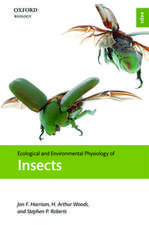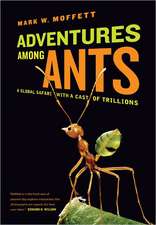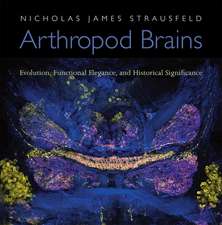Neuroanatomical Techniques: Insect Nervous System: Springer Series in Experimental Entomology
Editat de N. J. Strausfeld Contribuţii de J. S. Altman Editat de T. a. Milleren Limba Engleză Paperback – 4 noi 2011
Preț: 651.84 lei
Preț vechi: 766.87 lei
-15% Nou
Puncte Express: 978
Preț estimativ în valută:
124.72€ • 130.24$ • 102.100£
124.72€ • 130.24$ • 102.100£
Carte tipărită la comandă
Livrare economică 15-29 aprilie
Preluare comenzi: 021 569.72.76
Specificații
ISBN-13: 9781461260202
ISBN-10: 1461260205
Pagini: 532
Ilustrații: 496 p.
Dimensiuni: 155 x 235 x 30 mm
Greutate: 0.74 kg
Ediția:Softcover reprint of the original 1st ed. 1980
Editura: Springer
Colecția Springer
Seria Springer Series in Experimental Entomology
Locul publicării:New York, NY, United States
ISBN-10: 1461260205
Pagini: 532
Ilustrații: 496 p.
Dimensiuni: 155 x 235 x 30 mm
Greutate: 0.74 kg
Ediția:Softcover reprint of the original 1st ed. 1980
Editura: Springer
Colecția Springer
Seria Springer Series in Experimental Entomology
Locul publicării:New York, NY, United States
Public țintă
ResearchCuprins
1 The Methylene Blue Technique: Classic and Recent Applications to the Insect Nervous System.- I. Historical Review.- II. Methods.- III. The Staining Schedule.- IV. Recent Applications of the Method.- V. Further Developments of the Method.- 2 Permanent Staining of Tracheae with Trypan Blue.- I. Essentials of the Technique.- II. Practical Procedure.- III. Results and Comments.- 3 Toluidine Blue as a Rapid Stain for Nerve Cell Bodies in Intact Ganglia.- I. Stain.- II. Differentiator and Fixative.- III. Dehydration and Mounting.- IV. Results.- V. Special Applications.- 4 Demonstration of Neurosecretory Cells in the Insect Central Nervous System.- I. Methods for NSC Detection.- II. Comparisons of Present-Day Neurosecretory Staining Methods.- III. Conclusions.- 5 Histochemical Demonstration of Biogenic Monoamines (Falck-Hillarp Method) in the Insect Nervous System.- I. General Considerations.- II. Procedure.- III. Fluorescence Microscopy.- IV. Microspectrofluorometry.- 6 The Bodian Protargol Technique.- I. Practical Procedure.- II. Factors Affecting Staining.- III. Choice of Staining Conditions.- IV. Fault Tracing.- 7 Reduced Silver Impregnations Derived from the Holmes Technique.- I. Basic Strategies of Silver Impregnation.- II. Fixation.- III. Embedding and Sectioning.- IV. A Basic Schedule for Holmes-Blest Impregnations.- V. The Holmes-Rowell Method.- VI. Weiss’s Method.- VII. Pretreatment with Dilute Nitric Acid.- VIII. Cobalt-Mercury Mordanting.- IX. Varying the Processing Strategies.- X. General Comments on Handling Sections.- XI. Results.- 8 Reduced Silver Impregnations of the Ungewitter Type.- I. Mordanting: The Use of Mercury Pretreatment.- II. Basic Schedule for a Urea-Silver Nitrate Impregnation.- III. Choice of Variants.- IV. Comparative Conclusions.- 9 TheGolgi Method: Its Application to the Insect Nervous System and the Phenomenon of Stochastic Impregnation.- I. Historical Background.- II. Use of the Method and Its Selectivity.- III. Summary of the Basic Procedures.- IV. Golgi Procedures for Insect Central Nervous System.- V. The Golgi-Colonnier and Golgi-Rapid Procedures.- VI. The Nature of Random Impregnation.- VII. Possible Events During Silver Impregnation.- VIII. Golgi Methods Using Mercury Salts.- IX. Conclusions.- X. Appendix I: A Model of Random Impregnation.- XI. Appendix II: Methods.- 10 Electron-Microscopic Methods for Nervous Tissues.- I. Fixation.- II. Embedding.- III. Sectioning.- IV. Staining Ultrathin Sections.- V. Appendix I: Buffer Solutions.- VI. Appendix II: List of Suppliers.- 11 Methods for Special Staining of Synaptic Sites.- I. Methodology.- II. Phosphotungstic Acid Technique.- III. The Bismuth Iodide-Uranyl Acetate-Lead Citrate Technique.- IV. Zinc Iodide-Osmium Tetroxide Stain.- V. Conclusions and Outlook.- VI. Addendum.- 12 Experimental Anterograde Degeneration of Nerve Fibers: A Tool for Combined Light- and Electron-Microscopic Studies of the Insect Nervous System.- I. Choice of Animal.- II. Experimental Lesions to the Nerve Cord: Controlled Surgery.- III. Timing of Postoperative Survival.- IV. Preparation for Light and Electron Microscopy.- V. Structural Aspects of Anterograde Degeneration.- VI. Light Microscopy.- VII. Ultrastructural Observations.- VIII. Physiologic and Chemical Correlates of Anterograde Degeneration.- IX. Concluding Remarks.- X. Addendum.- 13 Simple Axonal Filling of Neurons with Procion Yellow.- I. The Immersion Method.- II. The Two-Bath Method.- III. The Two Methods Compared.- 14 Intracellular Staining with Fluorescent Dyes.- I. Procion Dyes.- II. Procion as a RecordingElectrode.- III. Injection of Procion.- IV. Fixation.- V. Viewing.- VI. Photography.- VII. Lucifer Yellow.- 15 Intracellular Staining of Insect Neurons with Procion Yellow.- I. Recording.- II. Dye Injection.- III. Histology.- IV. Fluorescence Microscopy.- V. Reconstruction.- VI. Fly Interneurons.- VII. Concluding Remarks.- 16 The Use of Horseradish Peroxidase as a Neuronal Marker in the Arthropod Central Nervous System.- I. History and Chemical Nature of Horseradish Peroxidase.- II. Materials and Methods.- III. Results and Discussion.- IV. Uptake and Transport of HRP by Nerve Cells.- V. Technical Considerations.- VI. Concluding Remarks.- 17 Cobalt Staining of Neurons by Microelectrodes.- I. General Methods.- II. Applications and Interpretations.- 18 Nonrandom Resolution of Neuron Arrangements.- I. The Method.- II. Injection and Diffusion Parameters.- III. Species-Specific Variations of the Methods.- IV. Peripheral Fillings via Micropipettes.- V. Cobalt Precipitation.- VI. Resolution of the Cobalt Reservoir and Nerve Cells.- VII. Patterns of Uptake by Neurons.- VIII. A Simple Comparison between the Golgi Method and the Cobalt Injection Technique.- 19 Filling Selected Neurons with Cobalt through Cut Axons.- I. Methods for Introducing Cobalt Chloride into Cut Axons.- II. Filling Selected Neurons.- III. Processing after Filling.- IV. Examination and Analysis.- V. Errors and Artifacts: Cautions for Interpretation.- VI. Tactics for Identifying the Origin of a Neuron or Tract.- VII. Conclusions.- VIII. Addendum.- 20 Silver-Staining Cobalt Sulfide Deposits within Neurons of Intact Ganglia.- I. Silver Intensification Procedure.- II. Methodology.- III. General Considerations.- 21 Intensification of Cobalt-Filled Neurons in Sections (Light and Electron Microscopy).- I. Timm’sSulfide-Silver Intensification Method for Cobalt.- II. Light Microscopy.- III. Electron Microscopy.- IV. Sensitivity of Timm’s Method.- References.




























